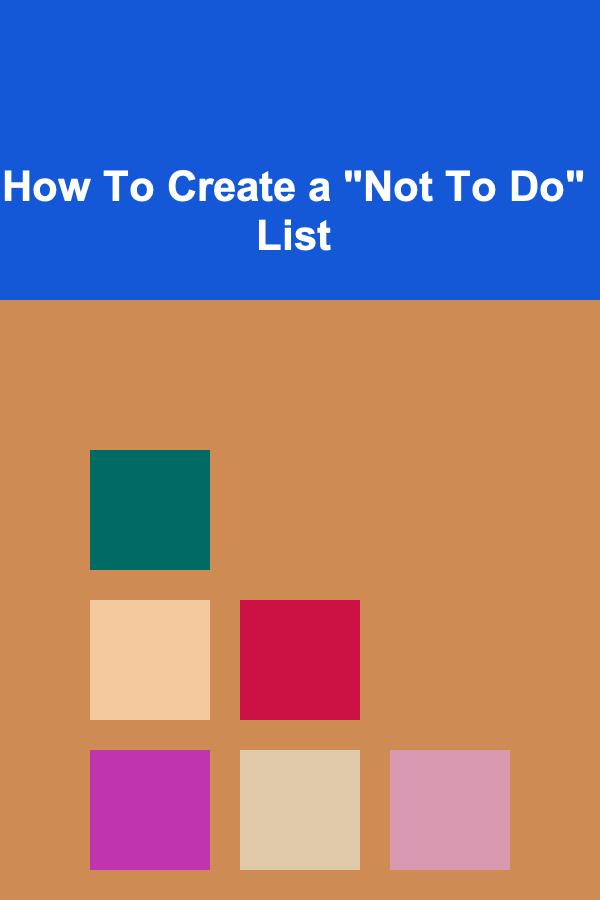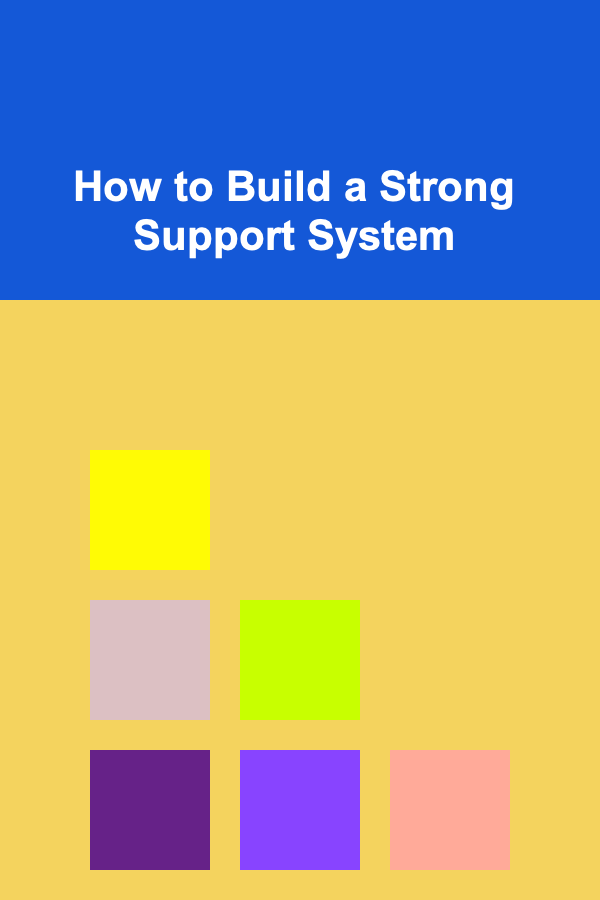
How To Create a "Not To Do" List
ebook include PDF & Audio bundle (Micro Guide)
$12.99$9.99
Limited Time Offer! Order within the next:

In a world full of distractions and endless to-do lists, creating a "Not To Do" list can be an incredibly powerful tool for increasing productivity, enhancing focus, and maintaining mental clarity. Often, we focus too much on what we need to do, while neglecting the importance of identifying what we shouldn't be doing. A "Not To Do" list is an effective way to avoid unnecessary tasks, reduce stress, and make sure that your time and energy are dedicated to the most important priorities.
While a "Not To Do" list may sound simple, its power lies in its ability to help you remove distractions and focus on what truly matters. In this article, we will explore the concept of a "Not To Do" list in detail, including why it's important, how to create one, and how to use it to boost productivity and well-being.
The Importance of a "Not To Do" List
1. Understanding the Power of Saying No
One of the biggest challenges people face today is the constant pressure to say yes to everything. We're asked to attend meetings, take on additional tasks, answer emails, and respond to requests---all of which can leave us feeling overwhelmed and stretched thin. A "Not To Do" list helps you identify what to say no to, allowing you to prioritize your time and energy more effectively.
By saying no to distractions, low-value activities, and commitments that don't align with your goals, you can create more space in your life for the things that matter most. Instead of feeling burdened by a never-ending to-do list, you can reclaim your time and focus on your most important tasks.
2. Enhancing Focus and Clarity
When your mind is cluttered with tasks and commitments that aren't important, it becomes harder to stay focused on what truly matters. A "Not To Do" list helps you create clarity by eliminating distractions and reminding you of the things that should be avoided. With fewer distractions, you can focus your attention on the tasks that align with your goals and values, ultimately increasing your productivity and effectiveness.
3. Reducing Stress and Overwhelm
Stress often arises when we feel like we have too much to do and not enough time to do it. A "Not To Do" list can help reduce this stress by providing a clear framework for identifying which tasks can be eliminated or delayed. By proactively deciding what not to do, you can prevent burnout and focus on maintaining a healthy balance between work and rest.
4. Improving Decision-Making
Creating a "Not To Do" list helps improve your decision-making by clarifying what's truly important to you. When you have a clear sense of what should be avoided, it becomes easier to make decisions that are aligned with your long-term goals. This can prevent you from getting sidetracked by opportunities that don't serve your best interests and allow you to invest your time in the things that will make the greatest impact.
5. Promoting Personal Growth
A "Not To Do" list isn't just about productivity; it's also about personal growth. By consciously identifying behaviors, habits, and tasks that aren't serving your personal development, you can take proactive steps to remove them from your life. This allows you to focus on habits that support your growth and well-being, such as exercising, learning new skills, and nurturing meaningful relationships.
How to Create a "Not To Do" List
1. Reflect on Your Current Habits and Responsibilities
The first step in creating a "Not To Do" list is to take an honest look at your current habits, routines, and responsibilities. This requires reflection and self-awareness to identify areas where you're wasting time or energy on unimportant tasks. Ask yourself questions like:
- What tasks are taking up too much of my time without yielding significant results?
- What activities drain my energy or contribute to stress?
- What commitments am I saying yes to out of guilt or obligation, rather than personal interest or benefit?
- Are there habits or behaviors that I want to break, such as procrastination or excessive social media use?
By answering these questions, you can begin to identify the specific tasks, habits, and behaviors that should be avoided.
2. Categorize Your "Not To Do" List
Once you've identified the areas where you need to make changes, it's helpful to categorize them into different groups. This can make it easier to prioritize and manage your "Not To Do" list. Some potential categories include:
- Time-Wasting Activities: These are tasks that don't contribute to your goals or personal development. Examples might include checking social media excessively, watching TV for hours, or engaging in endless email exchanges that don't add value.
- Negative Habits: These are behaviors that negatively impact your mental, physical, or emotional well-being. This could include habits like procrastination, perfectionism, or neglecting self-care.
- Unnecessary Commitments: These are obligations that you've taken on but that don't align with your goals or values. Examples could include attending social events you don't enjoy or taking on work tasks that could be delegated to someone else.
- Toxic Relationships: These are relationships that drain your energy, cause stress, or hinder your personal growth. Recognizing when to set boundaries with toxic individuals is an important part of your "Not To Do" list.
By categorizing your "Not To Do" list, you can make it more actionable and specific.
3. Set Clear Boundaries
A key aspect of creating a "Not To Do" list is setting boundaries. Boundaries help protect your time, energy, and well-being. Once you've identified the activities or commitments that don't serve you, you need to establish boundaries to prevent them from taking up valuable space in your life.
Setting boundaries might involve saying no to certain requests, turning off notifications on your phone, or delegating tasks that don't require your direct involvement. It might also involve setting limits on how much time you spend on certain activities, like watching TV or scrolling through social media.
4. Prioritize and Eliminate
While your "Not To Do" list will likely include many items, it's important to prioritize and eliminate the most impactful ones first. Start by focusing on the tasks or habits that are having the greatest negative effect on your productivity, well-being, or happiness. By eliminating the most critical distractions and time-wasters, you'll quickly start to feel a sense of relief and increased focus.
5. Continuously Review and Adjust Your "Not To Do" List
Creating a "Not To Do" list is not a one-time activity; it's an ongoing process. As you grow and evolve, your priorities and goals may change, and so should your "Not To Do" list. Regularly review your list and assess whether any new tasks or habits should be added or removed. This ensures that your list remains relevant and aligned with your current objectives.
6. Use Technology to Support Your "Not To Do" List
While a traditional pen-and-paper approach to a "Not To Do" list can be effective, you can also use technology to support your efforts. There are numerous apps and tools available that can help you stay on track and remind you to avoid certain behaviors or tasks. For example:
- Task Management Apps: Use task management apps like Todoist or Trello to organize your "Not To Do" list and track progress in real-time.
- Time-Tracking Apps: Apps like RescueTime or Toggl can help you monitor how much time you're spending on specific activities and identify areas where you may need to improve.
- Focus Apps: Apps like Focus@Will or Forest can help you stay focused by blocking distracting websites or promoting a distraction-free environment.
7. Make Your "Not To Do" List Visible
One of the keys to successfully adhering to your "Not To Do" list is making it visible and accessible. Whether you keep it on your phone, in a notebook, or on a wall in your workspace, having constant reminders of what not to do can help reinforce your commitment. This constant visibility acts as a gentle reminder to avoid distractions and maintain focus on your most important tasks.
Common Pitfalls to Avoid
While creating a "Not To Do" list can be highly beneficial, there are a few common pitfalls to watch out for:
1. Being Too Rigid
While it's important to have boundaries and avoid distractions, it's also crucial not to be too rigid. Life is unpredictable, and there may be times when you need to deviate from your list. Be flexible and allow for occasional exceptions when necessary.
2. Overcomplicating the List
A "Not To Do" list should be simple and focused. Avoid overcomplicating it with too many items or unrealistic goals. The purpose of the list is to help you reduce distractions, not add more complexity to your life.
3. Ignoring the Emotional Aspect
Sometimes, we engage in unproductive behaviors or take on unnecessary tasks because of emotional reasons, such as guilt, fear of missing out, or a need for approval. A "Not To Do" list should address these emotional triggers as well, so you can make conscious decisions that align with your values and goals.
Conclusion
Creating a "Not To Do" list is an incredibly powerful tool for enhancing productivity, reducing stress, and improving focus. By identifying the tasks, habits, and commitments that don't serve you, you can reclaim your time and energy, allowing you to dedicate yourself to what truly matters. With regular reflection, boundary-setting, and prioritization, you can use your "Not To Do" list to maintain mental clarity, achieve your goals, and ultimately lead a more fulfilling life.
Reading More From Our Other Websites
- [Gardening 101] How to Choose the Perfect Garden Trellis for Your Plants
- [Organization Tip 101] How to Display Vintage Collectibles Without Clutter
- [Personal Investment 101] How to Get Started with Impact Investing for Social Good
- [Home Renovating 101] How to Follow the Best Home Renovation Blogs for Inspiration and Tips
- [Personal Finance Management 101] How to Manage Your Finances as a Freelancer or Self-Employed
- [Home Budget 101] How to Automate Your Home Budget to Save Time and Money
- [Personal Care Tips 101] How to Stay Active When You Have a Desk Job
- [Personal Investment 101] How to Protect Your Investments from Inflation and Market Volatility
- [Home Storage Solution 101] How to Maximize Storage in Your Bedroom Without Overcrowding
- [Personal Care Tips 101] How to Choose Personal Care Products That Keep You Feeling Fresh

How to Style Your Front Porch for a Festive Holiday Welcome
Read More
How to Use Vertical Space in Your Home for Efficient Storage
Read More
How to Build a Strong Support System
Read More
Choosing the Right Lip Balm for Hydration
Read More
10 Tips for Prioritizing Tasks in Your To-Do List Planner
Read More
How to Habit Track for Financial Wellness
Read MoreOther Products

How to Style Your Front Porch for a Festive Holiday Welcome
Read More
How to Use Vertical Space in Your Home for Efficient Storage
Read More
How to Build a Strong Support System
Read More
Choosing the Right Lip Balm for Hydration
Read More
10 Tips for Prioritizing Tasks in Your To-Do List Planner
Read More